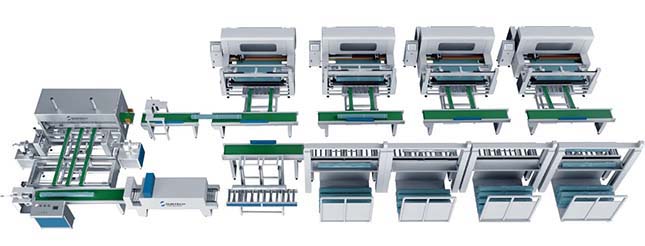Automation has brought about a transformative revolution in the operations of businesses and industries. By minimizing labor costs and enhancing overall efficiency and productivity, an automated fabric roll packing line presents numerous benefits for your organization. Discover the remarkable features, advantages, and cutting-edge technology that make an automatic packaging machine(automated fabric roll packing line) the ideal solution for your production needs.

Operational Mechanism
An automated fabric roll packing line is a highly efficient production line designed to swiftly pack fabric rolls into containers. This advanced system comprises multiple stations, each dedicated to a specific task within the packing process.
The initial station serves as the entry point for the fabric rolls into the line. Subsequently, they are conveyed to the following station where precise positioning and cutting to size take place. Once this stage is completed, the fabric rolls seamlessly move on to the subsequent station, where they are skillfully wrapped and packed into containers. Finally, the containers are securely sealed and conveyed to the designated shipping area.
When it comes to packing a fabric roll, there are several important factors to consider. Firstly, ensure that the roll is thoroughly clean and devoid of any debris. Secondly, check that the end of the roll is securely fastened and not frayed. Thirdly, measure the width and length of the roll and determine the most suitable packaging approach.
Once you have prepared the fabric roll, it's time to commence the packing process. If you opt for using a box, begin by positioning the fabric roll on its side, ensuring a snug fit against one side of the box. Subsequently, fill any empty spaces surrounding the fabric roll with appropriate packing material, such as crumpled paper or bubble wrap. Once everything is in place, securely close the box and label it accordingly.
In the event that you choose not to utilize a box, simply wrap the fabric roll entirely with packing material. Ensure that the entire roll is thoroughly covered and then secure everything with tape. Lastly, label the package appropriately. By following these guidelines, you will be able to pack a fabric roll securely and efficiently, regardless of the chosen method.
Fabric Tensioning Devices
The market offers a wide variety of fabric tensioning devices, catering to diverse needs. Let's explore some of these options:
l Pneumatic Tensioners:
Utilizing air pressure, pneumatic tensioners ensure precise fabric tensioning. They are user-friendly and provide exceptional control over the tensioning process, making them a popular choice.
l Electronic Tensioners:
Equipped with electronic sensors, these tensioners measure fabric tension with utmost accuracy and repeatability. Their advanced technology offers reliable and consistent results, ideal for demanding applications.
l Mechanical Tensioners:
Mechanical tensioners rely on mechanical mechanisms to achieve fabric tensioning. While they tend to be more affordable compared to other types, they may require more expertise to operate effectively.
Types of Fabric Roll Packing Lines
In today's market, various types of fabric roll packing lines are available, each with its own set of advantages and considerations. It is essential to evaluate these options to find the one that aligns with your business requirements. Here are a few notable types:
1. Fully Automatic Lines
Among the most prevalent options, fully automatic fabric roll packing lines exemplify efficiency and convenience. For instance, SUNTECH's ST-ARPM represents a cutting-edge fabric rolling and packing line designed with automation in mind.
When selecting a fabric roll packing line, carefully assess the features, benefits, and limitations of each type to make an informed decision that best suits your organization's needs.
2. SUNTECH ST-ARPM: AUTOMATIC PACKAGING MACHINE
The SUNTECH ST-ARPM represents a cutting-edge solution specifically designed for high-volume production environments prioritizing speed and efficiency. Fully automatic fabric roll packing lines, like the ST-ARPM, have the remarkable capability to pack over double the number of rolls per hour compared to semi-automatic or manual lines. However, it is important to note that they may come with higher upfront costs and require elevated maintenance levels.
Another viable option is the semi-automatic fabric roll packing line. These lines offer faster operation compared to manual lines, albeit not as rapid as fully automatic alternatives. Semi-automatic lines strike a balance between affordability and maintenance requirements. Nevertheless, they may not be suitable for handling exceptionally large or heavy fabric rolls.
Lastly, manual fabric roll packing lines provide the greatest flexibility in terms of packaging options and can accommodate rolls of any size or weight. Although they are the slowest and least expensive option, they offer versatility and adaptability to diverse production needs.
While the technology showcased in this blog post holds promise, it is crucial to be aware of potential issues that can arise from improper usage of an automated fabric roll packing line. Inadequate storage or monitoring of fabric rolls could lead to wrinkling or damage. Additionally, neglecting regular maintenance of the line may result in breakdowns that disrupt the production process. Careful attention and adherence to best practices are essential for maximizing the benefits of automation in fabric roll packing.




